Life Cycle Greenhouse Gas Emission Assessment for Using Alternative Marine Fuels: A Very Large Crude Carrier (VLCC) Case Study
Abstract
:1. Introduction
2. Methods and Materials
2.1. Parameters of The VLCC
2.2. Life Cycle Assessment Method
2.2.1. Goal and Scope
- S1: MGO imported from overseas.
- S2: LNG imported from overseas.
- S3: Coal-based methanol produced in China.
- S4: Natural gas-based methanol produced in China.
- S5: Partial solar-based methanol produced in China.
- S6: Full solar and battery-based methanol produced in China.
- S7: Coal-based ammonia produced in China.
- S8: Natural gas-based ammonia produced in China.
- S9: Full solar and battery-based ammonia produced in China.
2.2.2. Life Cycle Inventory
- (1)
- Life cycle data of well-to-tank
- (2)
- Life cycle data of tank-to-wake
- Two cruising speeds, 14.5 knots of the service speed and 13.5 knots of economical speed, were considered to assess the changes in fuel consumption of the engines. At service speed, the ME output was set to be at the MCR point; at the economical speed, the ME output was set to be at 70% of the MCR point, which was suggested by the ship operator.
- For safety considerations, the VLCC’s speed was reduced when entering and leaving ports due to its large mass and inertia. In this regard, the speed of 6 knots was considered for 30 n.m. of in-ports navigation.
- The ship’s speed was reduced when transiting the Malacca Strait. According to the navigation requirements [36], there were various speed restrictions from the One Fathom Bank to the Eastern Bank (482 n.m.), as shown in Figure 2. This paper considered that 40 h were needed to go through the strait at an average speed of 12 knots.
3. Results
3.1. Well-to-Tank Emissions
3.2. Tank-to-Wake Emissions
3.3. Well-to-Wake Emissions
4. Discussion
4.1. N2O Emission Abatement from Ammonia Fuelled Engines
4.2. GHG Emission Reduction Potential
- Solar PV cannot generate electricity at night; thus, electricity supply for fuel production relies on the electricity generated during the day stored in the battery system. The GHG emissions from battery manufacturing were also included in the total emissions of the fuel production process. This led to the conclusion that the emissions from the full solar and battery-based methanol and ammonia production were higher than expected.
- The calorific value of these low-carbon fuels was relatively low, resulting in more significant annual fuel consumption, which led to higher emissions.
5. Conclusions
- The WTT GHG emissions of fossil energy-based methanol and ammonia were significantly higher than those of fossil fuels, MGO, and LNG. Partial solar-based methanol was also not competitive. Only full solar and battery-based methanol had apparent advantages.
- The TTW GHG emissions of using alternative fuels showed varying degrees of advantages compared to MGO. The emission reduction effect of ammonia was the most significant, followed by LNG and methanol.
- From a WTW perspective, fossil fuel-based methanol and ammonia and partial solar-based methanol had no emissions reduction effects. Compared to MGO, full solar and battery-based methanol was the optimal option, followed by full solar and battery-based ammonia and LNG. However, if the N2O emitted from the ammonia engine was disposed of, then using full solar and battery-based ammonia with 90%-N2O-off after-treatment technology would be preferable to using full solar and battery-based methanol.
- Within the scope considered in this paper, compared to MGO, the ranking of the WTW GHG emission reduction effect of alternative fuels was as follows: full solar and battery-based ammonia with 90%-N2O-off, full solar and battery-based methanol, full solar and battery-based ammonia with 50%-N2O-off, full solar and battery-based ammonia with 30%-N2O-off, full solar and battery-based ammonia without N2O-off, and LNG.
- Pilot fossil fuels are required in current internal combustion engines, therefore, even using zero-carbon fuels, ships cannot achieve zero GHG emissions.
- Under ideal conditions, solar-based hydrogen-to-methanol could be approximately carbon-neutral over the entire life cycle. In fact, due to the discontinuity of solar power generation, lithium batteries are needed to store electricity. The GHG emissions of lithium batteries in the production process were included in the produced methanol, which makes the use of methanol as a marine fuel unable to achieve carbon neutrality. In the future, with the formation of a green power grid and the combined application of various renewable energy sources, the emission reduction potential of methanol could be further explored.
- Slowing the ship’s speed had a significant emission reduction effect.
Supplementary Materials
Author Contributions
Funding
Institutional Review Board Statement
Informed Consent Statement
Data Availability Statement
Conflicts of Interest
Abbreviations
| AE | Auxiliary engine |
| CH4 | Methane |
| CII | Carbon Intensity Indicator |
| CO2 | Carbon dioxide |
| CO2-eq | Carbon dioxide equivalent |
| DWT | Deadweight tonnage |
| EEDI | Energy Efficiency Design Index |
| EEXI | Energy Efficiency Existing Ship Index |
| GHG | Greenhouse gas |
| IMO | The International Maritime Organization |
| LCA | Life cycle assessment |
| LCI | Life cycle inventory analysis |
| LCIA | Life cycle impact assessment |
| LHV | Lower heating value |
| LNG | Liquified natural gas |
| MCR | Maximum continuous rating |
| ME | Main engine |
| MEPC | Marine environment protection committee |
| MGO | Marine gasoil |
| N2O | Nitrous oxide |
| PV | Photovoltaic |
| SFC | Specific fuel consumption |
| SMCR | Specified maximum continuous rating |
| SPOC | Specific pilot oil consumption |
| TTW | Tank-to-wake |
| VLCC | Very large crude carrier |
| WTT | Well-to-tank |
| WTW | Well-to-wake |
References
- IMO. Reduction of GHG Emissions from Ships—Fourth IMO GHG Study 2020—Final Report; IMO MEPC: London, UK, 2020.
- IMO. Guidelines on the Method of Calculation of the Attained Energy Efficiency Design Index (EEDI) for New Ships; IMO: London, UK, 2018.
- IPCC. Climate Change 2021: The Physical Science Basis; Cambridge University Press: Cambridge, UK, 2021. [Google Scholar]
- ABS. News Brief: MEPC 78; ABS: Houston, TX, USA, 2022. [Google Scholar]
- Al-Enazi, A.; Okonkwo, E.C.; Bicer, Y.; Al-Ansari, T. A review of cleaner alternative fuels for maritime transportation. Energy Rep. 2021, 7, 1962–1985. [Google Scholar] [CrossRef]
- Mallouppas, G.; Yfantis, E.A. Decarbonization in Shipping Industry: A Review of Research, Technology Development, and Innovation Proposals. J. Mar. Sci. Eng. 2021, 9, 415. [Google Scholar] [CrossRef]
- Schuller, O.; Kupferschmid, S.; Hengstler, J.; Whitehouse, S. 2nd Life Cycle GHG Emission Study on the Use of LNG as Marine Fuel; Sphera: Leinfelden-Echterdingen, Germany, 2021. [Google Scholar]
- Wang, S.; Qi, J.; Laporte, G. Governmental subsidy plan modeling and optimization for liquefied natural gas as fuel for maritime transportation. Transp. Res. Part B Methodol. 2022, 155, 304–321. [Google Scholar] [CrossRef]
- Lagemann, B.; Lindstad, E.; Fagerholt, K.; Rialland, A.; Ove Erikstad, S. Optimal ship lifetime fuel and power system selection. Transp. Res. Part D Transp. Environ. 2022, 102, 103145. [Google Scholar] [CrossRef]
- SEA\LNG. LNG—A Fuel in Transition. Available online: https://sea-lng.org/wp-content/uploads/2022/03/LNG-2022_A-view-from-the-bridge_.pdf (accessed on 10 January 2022).
- Fan, H.; Enshaei, H.; Jayasinghe, S.G. Formation of Dataset for Fuzzy Quantitative Risk Assessment of LNG Bunkering SIMOPs. Data 2022, 7, 60. [Google Scholar] [CrossRef]
- Brynolf, S.; Fridell, E.; Andersson, K. Environmental assessment of marine fuels: Liquefied natural gas, liquefied biogas, methanol and bio-methanol. J. Clean. Prod. 2014, 74, 86–95. [Google Scholar] [CrossRef]
- Fan, H.; Enshaei, H.; Jayasinghe, S.G.; Tan, S.H.; Zhang, C. Quantitative risk assessment for ammonia ship-to-ship bunkering based on Bayesian network. Process Saf. Prog. 2022, 41, 395–410. [Google Scholar] [CrossRef]
- Mandra, J.O. Clarksons: There Are 130 Ammonia-Ready and 6 Hydrogen-Ready Vessels On Order. Available online: https://www.offshore-energy.biz/clarksons-there-are-130-ammonia-ready-and-6-hydrogen-ready-vessels-on-order/ (accessed on 21 October 2022).
- Grzelakowski, A.S.; Herdzik, J.; Skiba, S. Maritime Shipping Decarbonization: Roadmap to Meet Zero-Emission Target in Shipping as a Link in the Global Supply Chains. Energies 2022, 15, 6150. [Google Scholar] [CrossRef]
- IMO. MEPC 76/7/4 Draft Guidelines on the Method of Calculation of the Attained Energy Efficiency Exist-Ing Ship Index (EEXI); IMO: London, UK, 2021.
- IMO. Resolution MEPC.281(70) Amendments to the 2014 Guidelines on the Method of Calculation of the Attained Energy Effi-Ciency Design Index (EEDI) for New Ships (Resolution MEPC.245(66), as Amended by Resolution MEPC.263(68)); IMO: London, UK, 2016.
- IMO. Resolution MEPC.336(76)—2021 Guidelines on Operational Carbon Intensity Indicators and the Calculation Methods (CII Guidelines, G1); IMO: London, UK, 2021.
- The IMO. Intersessional Working Group on Reduction of GHG Emissions from Ships (ISWG-GHG 9), 15–17 September 2021. Available online: https://www.imo.org/en/MediaCentre/MeetingSummaries/Pages/ISWG-GHG-9.aspx (accessed on 21 October 2022).
- Gilbert, P.; Walsh, C.; Traut, M.; Kesieme, U.; Pazouki, K.; Murphy, A. Assessment of full life-cycle air emissions of alternative shipping fuels. J. Clean. Prod. 2018, 172, 855–866. [Google Scholar] [CrossRef]
- Law, L.C.; Foscoli, B.; Mastorakos, E.; Evans, S. A Comparison of Alternative Fuels for Shipping in Terms of Lifecycle Energy and Cost. Energies 2021, 14, 8502. [Google Scholar] [CrossRef]
- Kanchiralla, F.M.; Brynolf, S.; Malmgren, E.; Hansson, J.; Grahn, M. Life-Cycle Assessment and Costing of Fuels and Propulsion Systems in Future Fossil-Free Shipping. Environ. Sci. Technol. 2022, 56, 12517–12531. [Google Scholar] [CrossRef] [PubMed]
- Hwang, S.S.; Gil, S.J.; Lee, G.N.; Lee, J.W.; Park, H.; Jung, K.H.; Suh, S.B. Life Cycle Assessment of Alternative Ship Fuels for Coastal Ferry Operating in Republic of Korea. J. Mar. Sci. Eng. 2020, 8, 660. [Google Scholar] [CrossRef]
- Wang, H.; Boulougouris, E.; Theotokatos, G.; Zhou, P.; Priftis, A.; Shi, G. Life cycle analysis and cost assessment of a battery powered ferry. Ocean Eng. 2021, 241, 110029. [Google Scholar] [CrossRef]
- Chen, Z.S.; Lam, J.S.L. Life cycle assessment of diesel and hydrogen power systems in tugboats. Transp. Res. Part D Transp. Environ. 2022, 103, 103192. [Google Scholar] [CrossRef]
- Fernández-Ríos, A.; Santos, G.; Pinedo, J.; Santos, E.; Ruiz-Salmón, I.; Laso, J.; Lyne, A.; Ortiz, A.; Ortiz, I.; Irabien, Á.; et al. Environmental sustainability of alternative marine propulsion technologies powered by hydrogen—A life cycle assessment approach. Sci. Total Environ. 2022, 820, 153189. [Google Scholar] [CrossRef]
- Wang, Y.; Maidment, H.; Boccolini, V.; Wright, L. Life cycle assessment of alternative marine fuels for super yacht. Reg. Stud. Mar. Sci. 2022, 55, 102525. [Google Scholar] [CrossRef]
- Seddiek, I.S.; Ammar, N.R. Carbon footprint and cost analysis of renewable hydrogen-fuelled ships. Ships Offshore Struct. 2022, 17, 1–10. [Google Scholar] [CrossRef]
- Lee, G.N.; Kim, J.M.; Jung, K.H.; Park, H.; Jang, H.S.; Lee, C.S.; Lee, J.W. Environmental Life-Cycle Assessment of Eco-Friendly Alternative Ship Fuels (MGO, LNG, and Hydrogen) for 170 GT Nearshore Ferry. J. Mar. Sci. Eng. 2022, 10, 755. [Google Scholar] [CrossRef]
- ISO. ISO 14040:2006 Environmental Management—Life Cycle Assessment—Principles and Framework; ISO: London, UK, 2006. [Google Scholar]
- Clemente, J. China Is The World’s Largest Oil & Gas Importer. Available online: https://www.forbes.com/sites/judeclemente/2019/10/17/china-is-the-worlds-largest-oil--gas-importer/?sh=462e73945441 (accessed on 23 October 2022).
- Zhu, R.; Wang, Z.; He, Y.; Zhu, Y.; Cen, K. LCA comparison analysis for two types of H2 carriers: Methanol and ammonia. Int. J. Energy Res. 2022, 46, 11818–11833. [Google Scholar] [CrossRef]
- IPCC. Climate Change 2014: Synthesis Report. Contribution of Working Groups I, II and III to the Fifth Assessment Report of the Intergovernmental Panel on Climate Change; IPCC: Geneva, Switzerland, 2014. [Google Scholar]
- Nizami, M.; Slamet; Purwanto, W.W. Solar PV based power-to-methanol via direct CO2 hydrogenation and H2O electrolysis: Techno-economic and environmental assessment. J. CO2 Util. 2022, 65, 102253. [Google Scholar] [CrossRef]
- Sun, X.; Tian, Z.; Malekian, R.; Li, Z. Estimation of Vessel Emissions Inventory in Qingdao Port Based on Big data Analysis. Symmetry 2018, 10, 452. [Google Scholar] [CrossRef] [Green Version]
- IMO. Rules For Vessels Navigating Through the Straits of Malacca and Singapore; IMO: London, UK, 1998.
- MAN Energy Solutions. CEAS Engine Calculations. Available online: https://www.man-es.com/marine/products/planning-tools-and-downloads/ceas-engine-calculations (accessed on 15 October 2022).
- Lindstrand, N. MAN Energy Solutions is developing a Fuel-Flexible, Two-Stroke Ammonia Engine as a Key Technology in the Maritime Energy Transition. Available online: https://www.man-es.com/discover/two-stroke-ammonia-engine (accessed on 2 November 2022).
- Atchison, J. WinGD to Develop Ammonia Maritime Engines by 2025. Available online: https://www.ammoniaenergy.org/articles/wingd-to-develop-ammonia-maritime-engines-by-2025/ (accessed on 2 November 2022).
- Laursen, R.S. Ship Operation Using LPG and Ammonia As Fuel on MAN B&W Dual Fuel ME-LGIP Engines. Available online: https://nh3fuelassociation.org/wp-content/uploads/2018/12/0900-Ammonia_vision-Rene-Sejer-Laursen-MAN.pdf (accessed on 2 November 2022).
- IEA. World Energy Outlook 2022. Available online: https://www.iea.org/reports/world-energy-outlook-2022 (accessed on 1 November 2022).

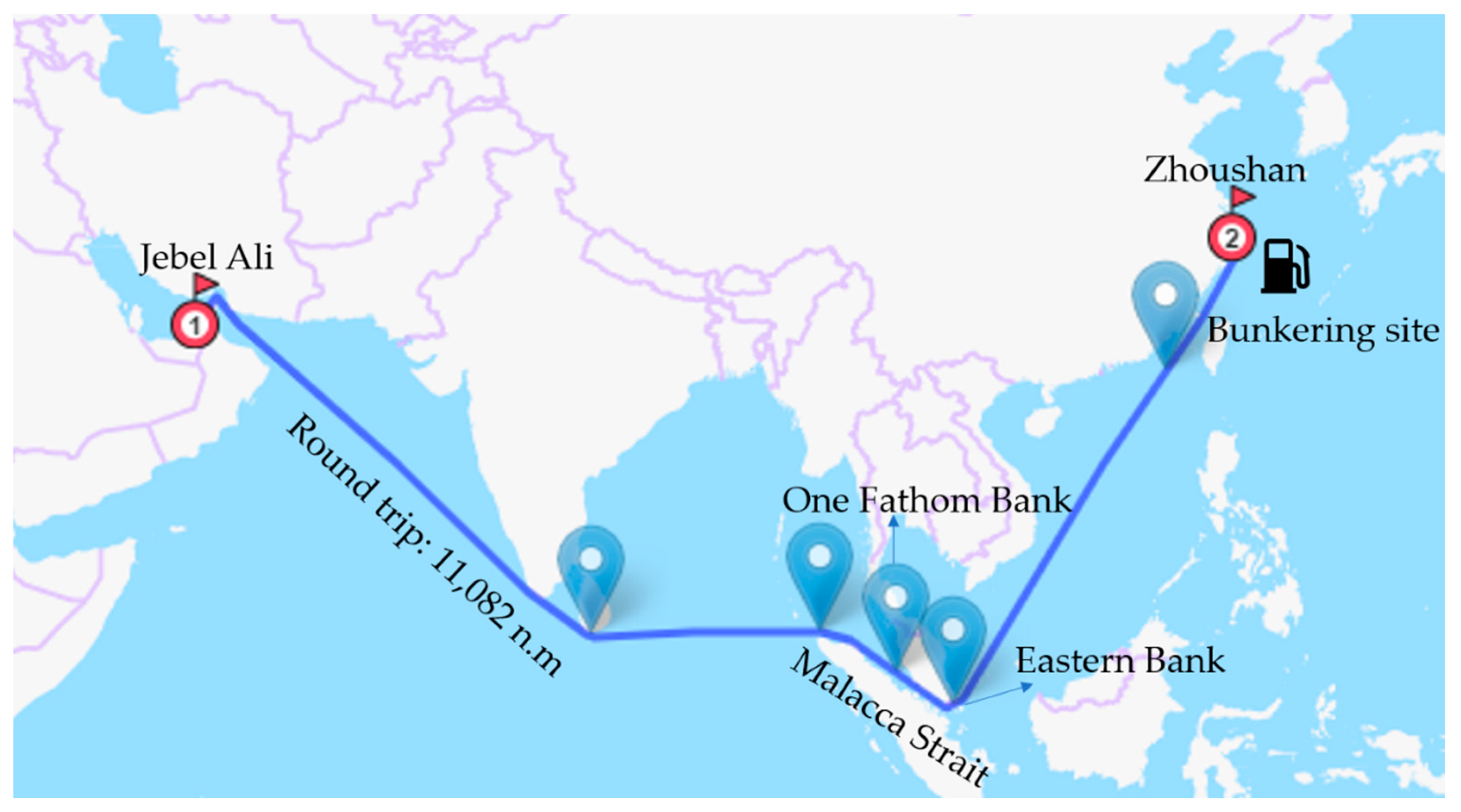
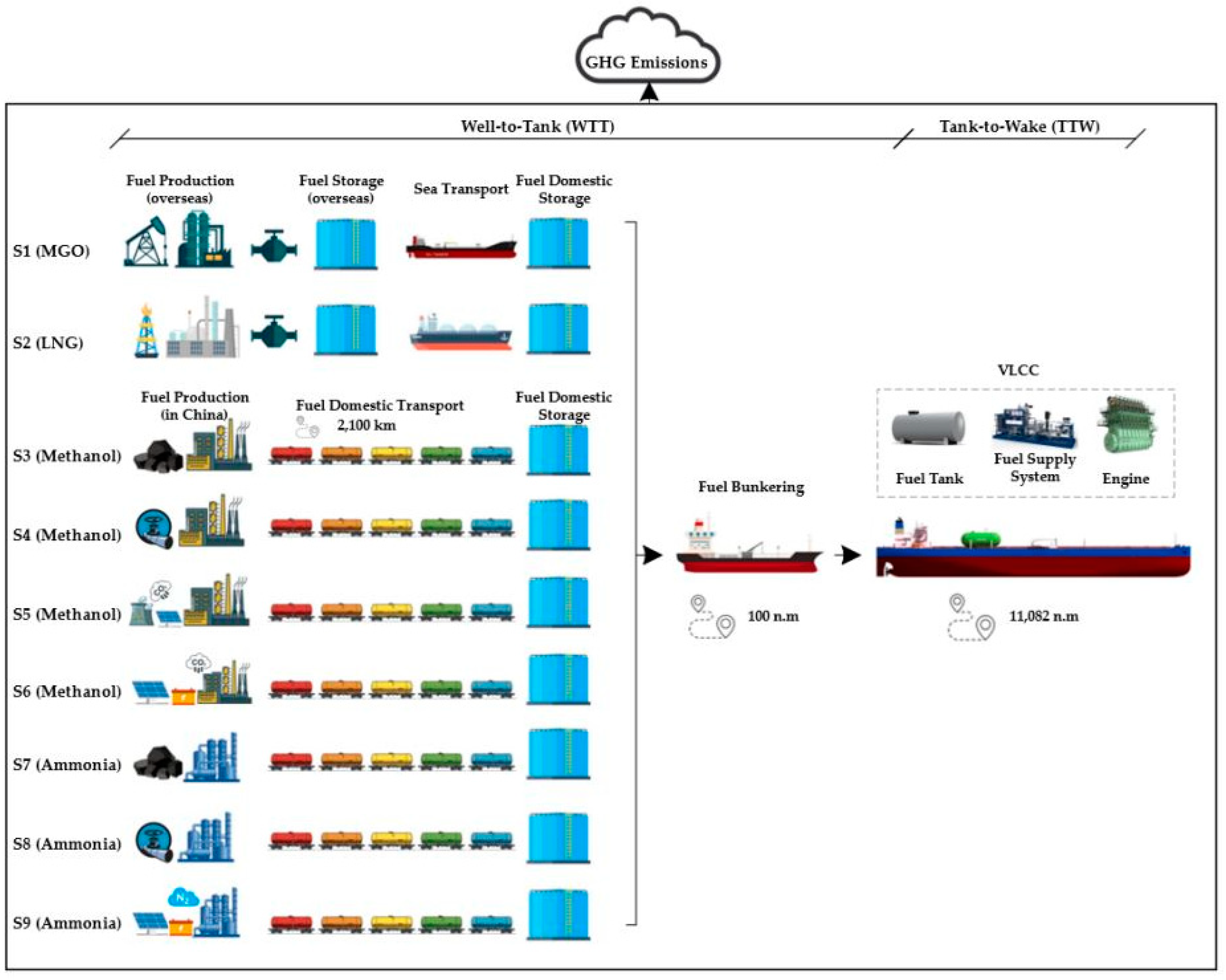
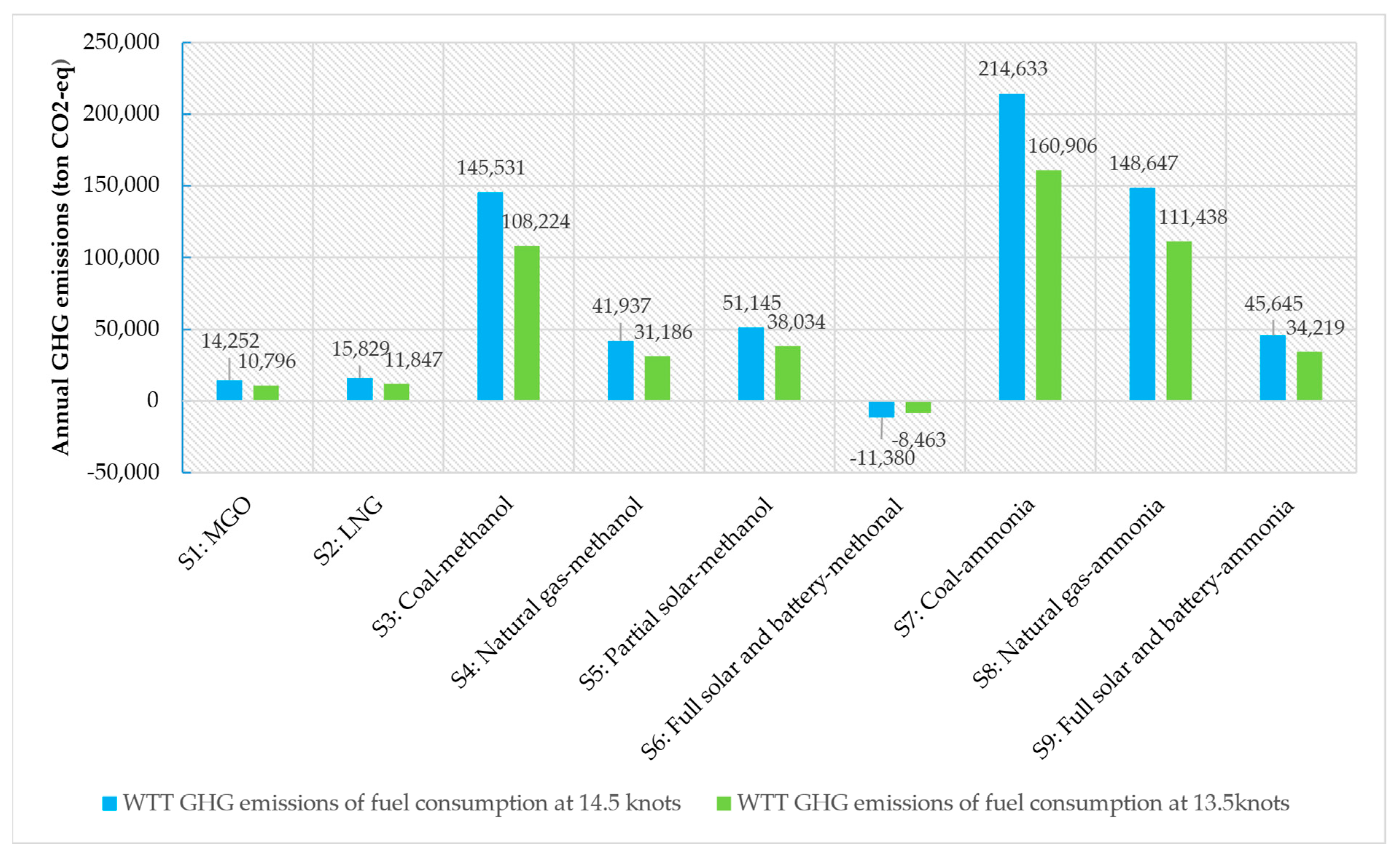

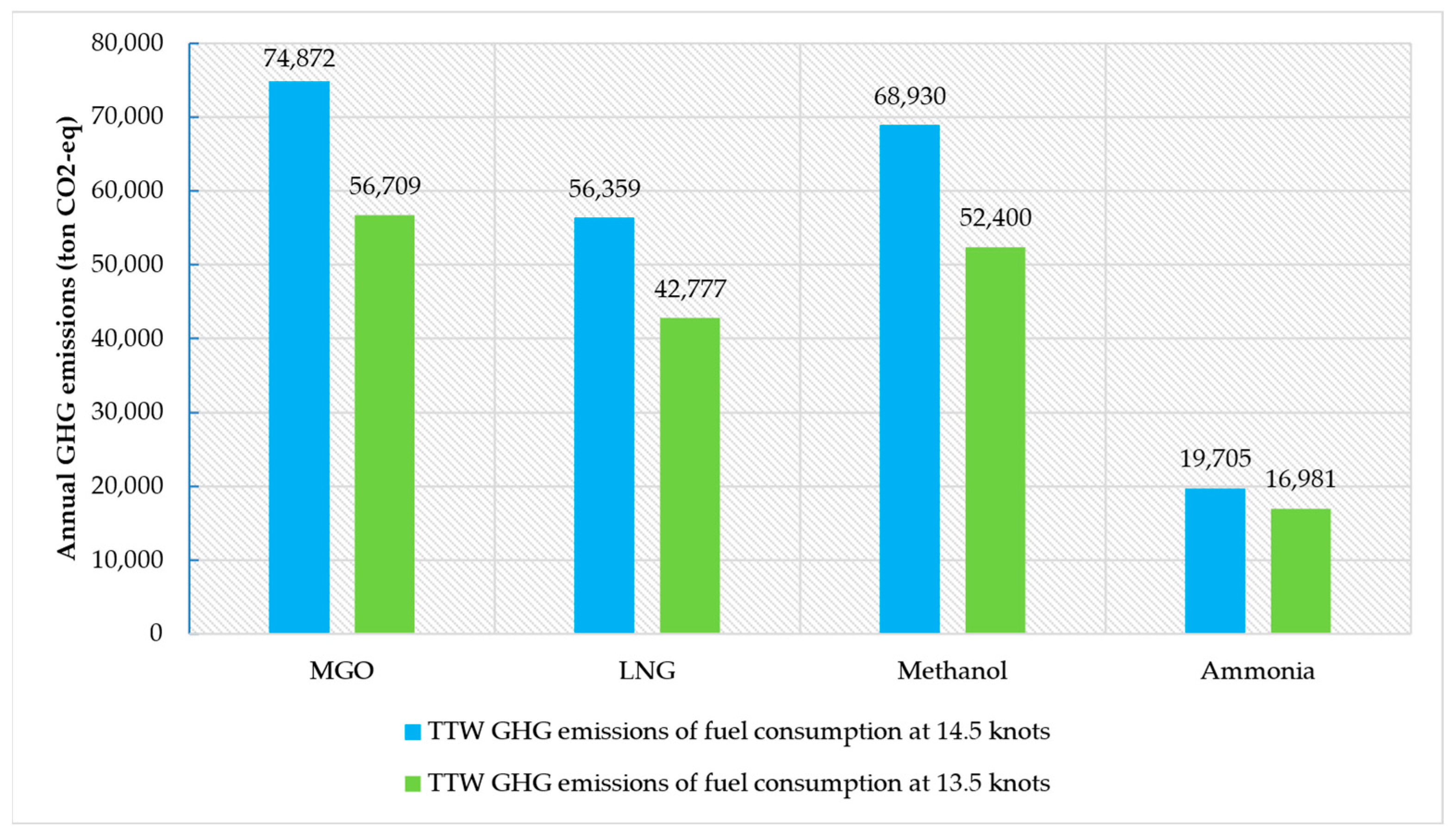
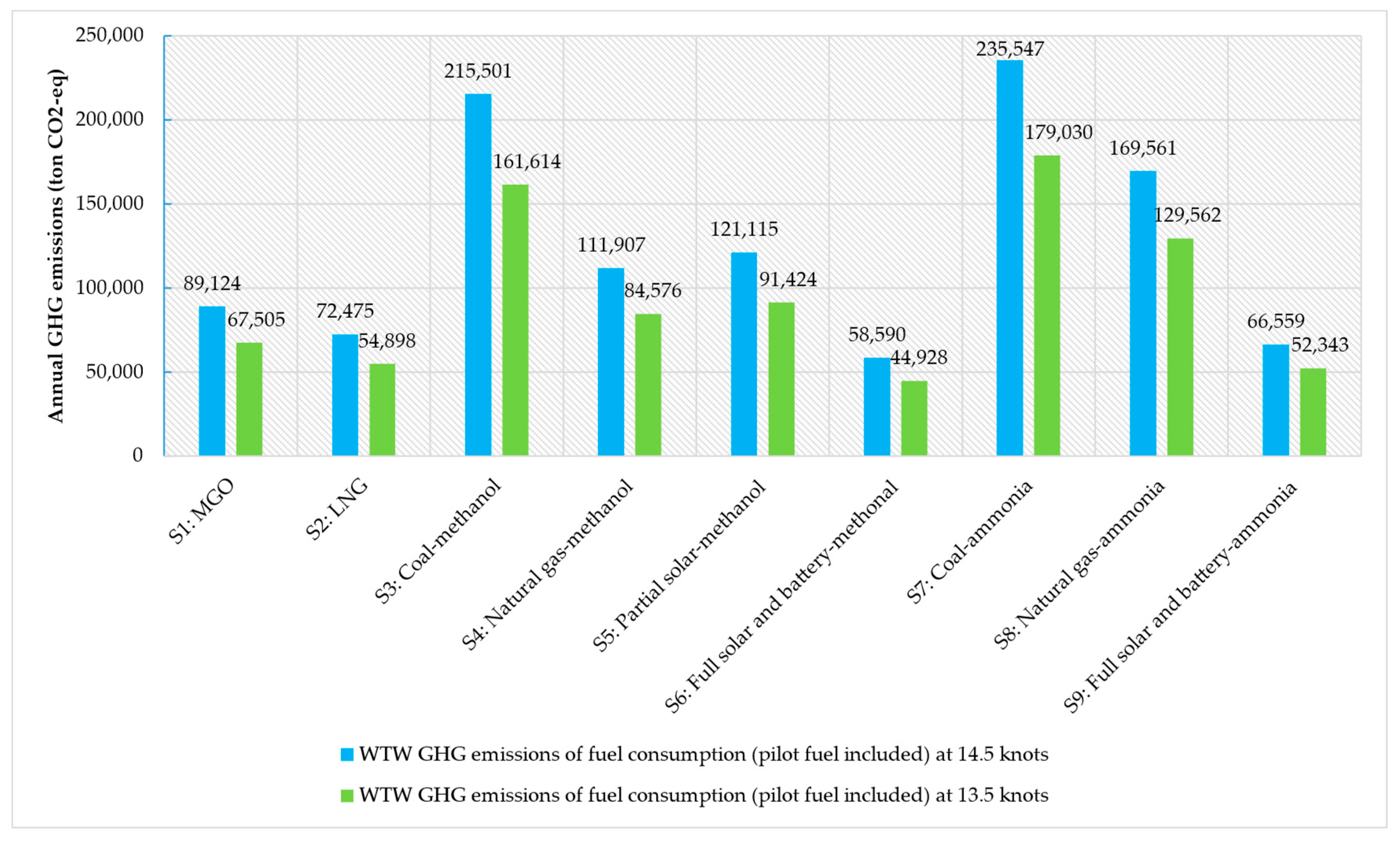
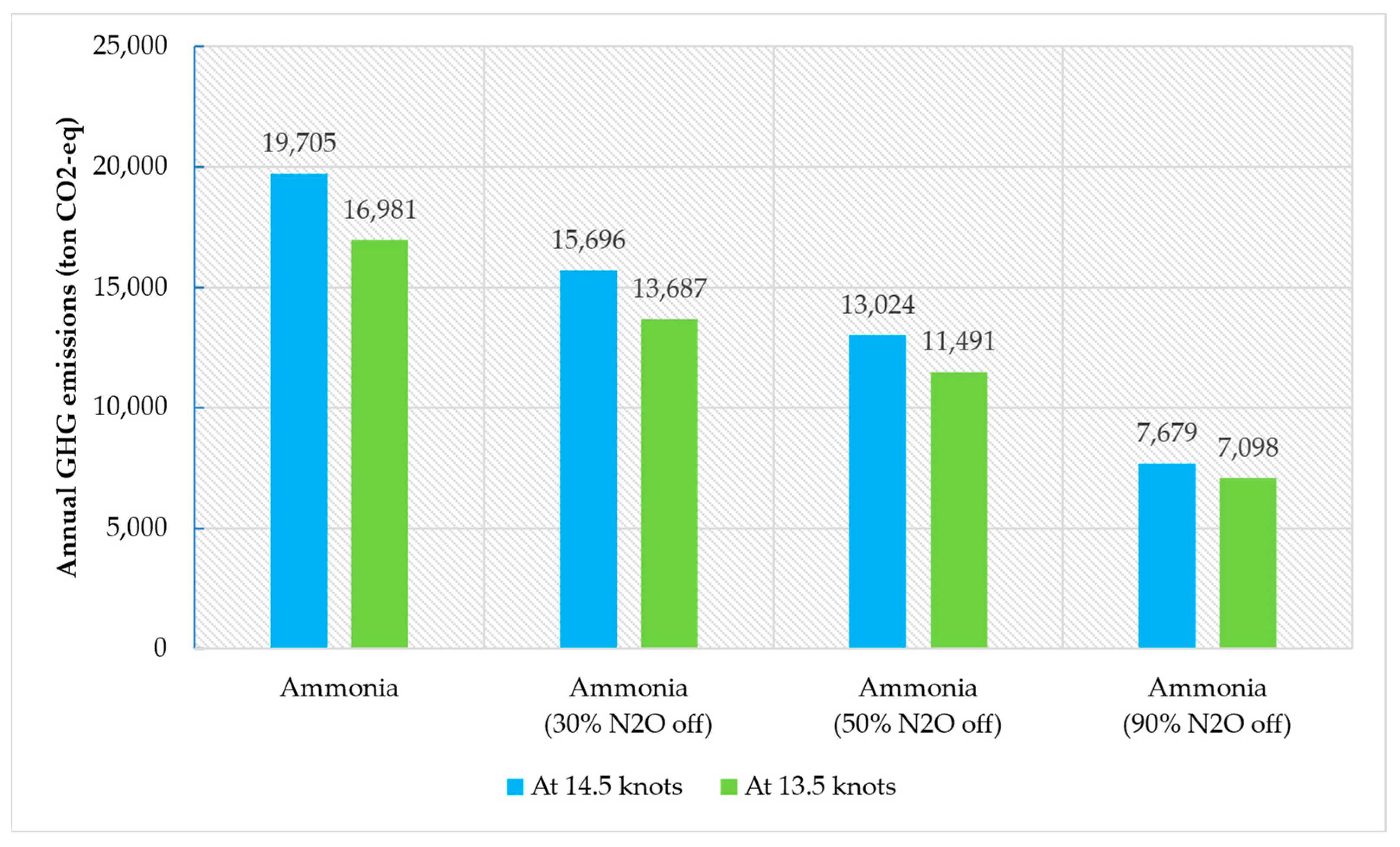
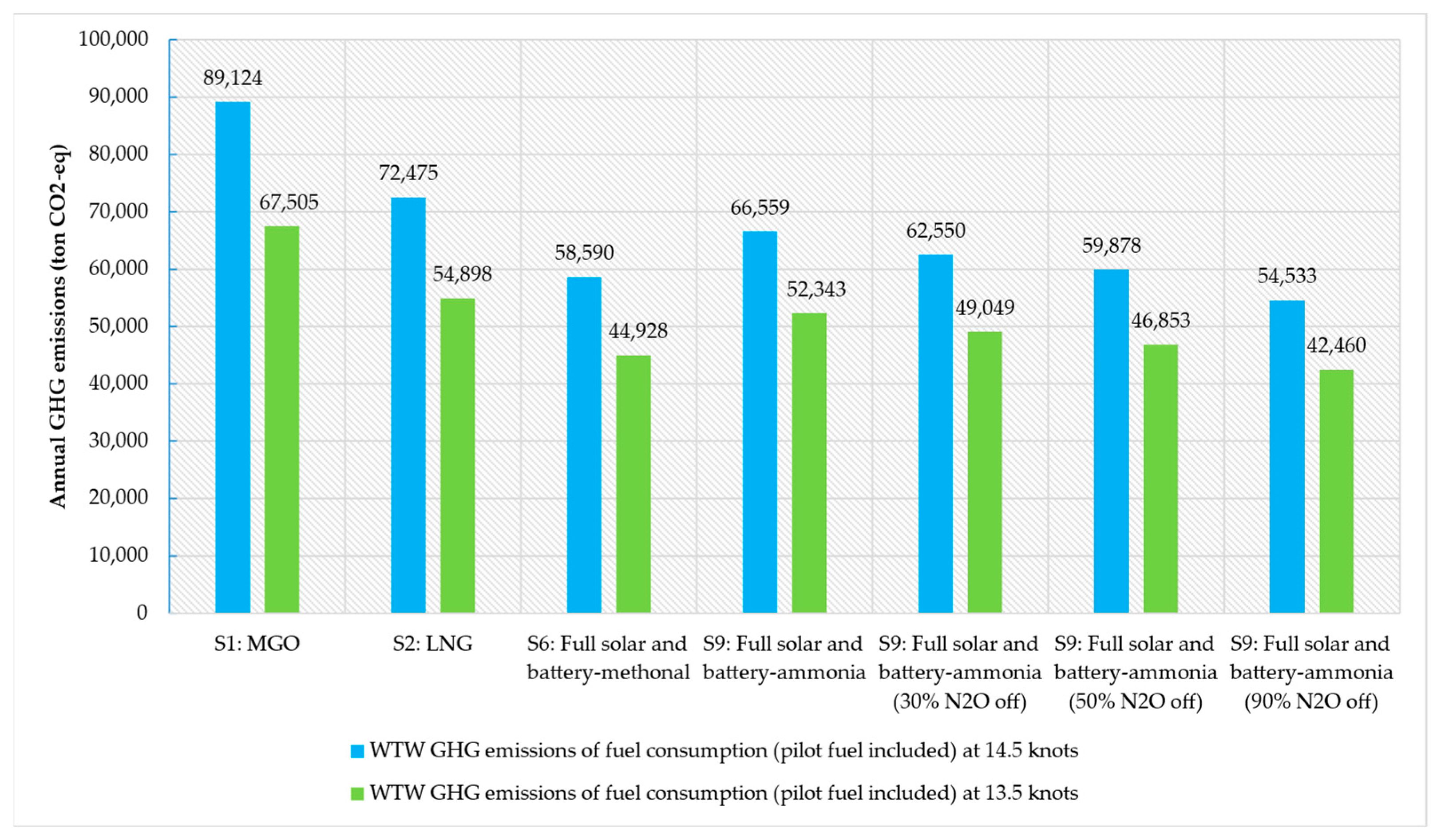
| Parameter | Value | Unit |
|---|---|---|
| Maximum deadweight tonnage (DWT) | 310,000 | tons |
| Length between perpendiculars | 333.0 | m |
| Moulded breadth | 60.0 | m |
| Depth | 30.0 | m |
| Design draft | 20.5 | m |
| Scantling draft | 22.0 | m |
| Service speed | 14.5 | knots |
| Economical speed | 13.5 | knots |
| Main engine rated power | 22,000 | kW |
| Subsystem | Production 1 | Transport | Bunkering | In Total |
|---|---|---|---|---|
| S1 | 0.62 | 0.0015 | 0.62 | |
| S2 | 0.73 | 0.12 | 0.0015 | 0.85 |
| S3 | 3.09 | 0.069 | 0.0015 | 3.16 |
| S4 | 0.84 | 0.069 | 0.0015 | 0.91 |
| S5 | 1.04 | 0.069 | 0.0015 | 1.11 |
| S6 | −0.32 2 | 0.069 | 0.0015 | −0.25 |
| S7 | 3.93 | 0.069 | 0.0015 | 4.00 |
| S8 | 2.7 | 0.069 | 0.0015 | 2.77 |
| S9 | 0.78 | 0.069 | 0.0015 | 0.85 |
| Cruising | Entering and Leaving Ports | Across the Malacca Strait | At Ports | |||||||||
|---|---|---|---|---|---|---|---|---|---|---|---|---|
| Speed (Knots) | Time (h) | Distance (n.m.) | Speed (Knots) | Time (h) | Distance (n.m.) | Speed (Knots) | Time (h) | Distance (n.m.) | Loading Time (h) | Unloading Time (h) | Standby Time (h) | |
| At 14.5 knots | 14.5 | 347 | 5029 | 6 | 5 | 30 | 12 | 40 | 482 | 36 | 36 | 78 |
| ME Propulsion Power (kW) | 22,000 | 5500 | 12,100 | 0 | ||||||||
| AE Power (kW) | 1400 | 1600 | 1200 | 1600 | 2000 | 800 | ||||||
| At 13.5 knots | 13.5 | 373 | 5029 | 6 | 5 | 30 | 12 | 40 | 482 | 36 | 36 | 53 |
| ME Propulsion Power (kW) | 15,400 | 5500 | 12,100 | 0 | ||||||||
| AE Power (kW) | 1200 | 1600 | 1200 | 1600 | 2000 | 800 | ||||||
| MGO | LNG | Methanol | Ammonia | ||
|---|---|---|---|---|---|
| ME Type | 7G80ME-C10.5-EGRTC | 7G80ME-C10.5-GI-EGRTC | 7G80ME-C10.5-LGIM-EGRTC | 7G80ME-C10.5-LGIA-EGRTC | |
| At 14.5 knots | SMCR (kW) | 22,000 | 22,000 | 22,000 | 22,000 |
| SFC (g/kWh) | 159.3 | 129 | 318.9 | 376.5 | |
| SPOC (g/kWh) | 0 | 3.2 | 10.67 | 10.6 | |
| Fuel Consumption (kg/h) | 3505 | 2838 | 7016 | 8283 | |
| Pilot Consumption (kg/h) | 0 | 70 | 235 | 233 | |
| At 13.5 knots | SMCR (kW) | 15,400 | 15,400 | 15,400 | 15,400 |
| SFC (g/kWh) | 153.2 | 122.2 | 299.6 | 358.6 | |
| SPOC (g/kWh) | 0 | 4.06 | 13.53 | 13.4 | |
| Fuel Consumption (kg/h) | 2359 | 1882 | 4614 | 5522 | |
| Pilot Consumption (kg/h) | 0 | 63 | 208 | 206 |
| MGO | LNG | Methanol | Ammonia | ||
|---|---|---|---|---|---|
| At 14.5 knots | SMCR (kW) | 1400 | 1400 | 1400 | 1400 |
| SFC (g/kWh) | 187 | 155.3 | 395 | 406 | |
| SPOC (g/kWh) | 0 | 2.6 | 20 | 44 | |
| Fuel Consumption (kg/round trip) | 274,426 | 227,935 | 579,669 | 595,812 | |
| Pilot Consumption (kg/round trip) | 0 | 3816 | 29,350 | 64,571 | |
| At 13.5 knots | SMCR (kW) | 1200 | 1200 | 1200 | 1200 |
| SFC (g/kWh) | 187 | 155.3 | 395 | 406 | |
| SPOC (g/kWh) | 0 | 2.6 | 20 | 44 | |
| Fuel Consumption (kg/round trip) | 252,533 | 209,751 | 533,426 | 548,280 | |
| Pilot Consumption (kg/round trip) | 0 | 3511 | 27,009 | 59,420 |
| Speed | Consumption (Ton/Year) | MGO | LNG | Methanol | Ammonia |
|---|---|---|---|---|---|
| At 14.5 knots | ME Fuel | 20,736 | 16,766 | 41,405 | 48,881 |
| ME Pilot MGO | 0 | 431 | 1438 | 1428 | |
| AE Fuel | 2195 | 1823 | 4637 | 4766 | |
| AE Pilot MGO | 0 | 31 | 235 | 517 | |
| At 13.5 knots | ME Fuel | 15,350 | 12,234 | 29,972 | 35,832 |
| ME Pilot MGO | 0 | 413 | 1377 | 1364 | |
| AE Fuel | 2020 | 1678 | 4267 | 4386 | |
| AE Pilot MGO | 0 | 28 | 216 | 475 |
| Engine | Fuel | CO2 | CH4 | CO2-eq (CH4) | N2O | CO2-eq (N2O) | CO2-eq (Total) |
|---|---|---|---|---|---|---|---|
| Two-stroke low-speed Diesel cycle ME | MGO | 3.21 | 6.53 × 10−5 | 1.83 × 10−3 | 2.22 × 10−4 | 5.88 × 10−2 | 3.27 |
| LNG | 2.75 | 1.64 × 10−3 | 4.58 × 10−2 | 2.45 × 10−4 | 6.51 × 10−2 | 2.86 | |
| Methanol | 1.38 | 3.34 × 10−5 | 9.35 × 10−4 | 1.00 × 10−5 | 2.65 × 10−3 | 1.38 | |
| Ammonia | 0 | 0 | 0 | 5.42 × 10−4 | 1.44 × 10−1 | 0.14 | |
| Four-stroke medium -speed Otto cycle AE | MGO | 3.21 | 5.35 × 10−5 | 1.50 × 10−3 | 1.60 × 10−4 | 4.25 × 10−2 | 3.25 |
| LNG | 2.75 | 3.54 × 10−2 | 9.92 × 10−1 | 1.29 × 10−4 | 3.41 × 10−2 | 3.78 | |
| Methanol | 1.38 | 2.53 × 10−5 | 7.09 × 10−4 | 7.59 × 10−6 | 2.01 × 10−3 | 1.38 | |
| Ammonia | 0 | 0 | 0 | 5.02 × 10−3 | 1.33 | 1.33 |
Publisher’s Note: MDPI stays neutral with regard to jurisdictional claims in published maps and institutional affiliations. |
© 2022 by the authors. Licensee MDPI, Basel, Switzerland. This article is an open access article distributed under the terms and conditions of the Creative Commons Attribution (CC BY) license (https://creativecommons.org/licenses/by/4.0/).
Share and Cite
Huang, J.; Fan, H.; Xu, X.; Liu, Z. Life Cycle Greenhouse Gas Emission Assessment for Using Alternative Marine Fuels: A Very Large Crude Carrier (VLCC) Case Study. J. Mar. Sci. Eng. 2022, 10, 1969. https://doi.org/10.3390/jmse10121969
Huang J, Fan H, Xu X, Liu Z. Life Cycle Greenhouse Gas Emission Assessment for Using Alternative Marine Fuels: A Very Large Crude Carrier (VLCC) Case Study. Journal of Marine Science and Engineering. 2022; 10(12):1969. https://doi.org/10.3390/jmse10121969
Chicago/Turabian StyleHuang, Jinjin, Hongjun Fan, Xiangyang Xu, and Zheyu Liu. 2022. "Life Cycle Greenhouse Gas Emission Assessment for Using Alternative Marine Fuels: A Very Large Crude Carrier (VLCC) Case Study" Journal of Marine Science and Engineering 10, no. 12: 1969. https://doi.org/10.3390/jmse10121969
APA StyleHuang, J., Fan, H., Xu, X., & Liu, Z. (2022). Life Cycle Greenhouse Gas Emission Assessment for Using Alternative Marine Fuels: A Very Large Crude Carrier (VLCC) Case Study. Journal of Marine Science and Engineering, 10(12), 1969. https://doi.org/10.3390/jmse10121969







